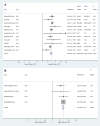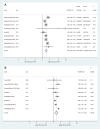Preterm birth and childhood wheezing disorders: a systematic review and meta-analysis
- PMID: 24492409
- PMCID: PMC3904844
- DOI: 10.1371/journal.pmed.1001596
Preterm birth and childhood wheezing disorders: a systematic review and meta-analysis
Abstract
Background: Accumulating evidence implicates early life factors in the aetiology of non-communicable diseases, including asthma/wheezing disorders. We undertook a systematic review investigating risks of asthma/wheezing disorders in children born preterm, including the increasing numbers who, as a result of advances in neonatal care, now survive very preterm birth.
Methods and findings: Two reviewers independently searched seven online databases for contemporaneous (1 January 1995-23 September 2013) epidemiological studies investigating the association between preterm birth and asthma/wheezing disorders. Additional studies were identified through reference and citation searches, and contacting international experts. Quality appraisal was undertaken using the Effective Public Health Practice Project instrument. We pooled unadjusted and adjusted effect estimates using random-effects meta-analysis, investigated "dose-response" associations, and undertook subgroup, sensitivity, and meta-regression analyses to assess the robustness of associations. We identified 42 eligible studies from six continents. Twelve were excluded for population overlap, leaving 30 unique studies involving 1,543,639 children. Preterm birth was associated with an increased risk of wheezing disorders in unadjusted (13.7% versus 8.3%; odds ratio [OR] 1.71, 95% CI 1.57-1.87; 26 studies including 1,500,916 children) and adjusted analyses (OR 1.46, 95% CI 1.29-1.65; 17 studies including 874,710 children). The risk was particularly high among children born very preterm (<32 wk gestation; unadjusted: OR 3.00, 95% CI 2.61-3.44; adjusted: OR 2.81, 95% CI 2.55-3.12). Findings were most pronounced for studies with low risk of bias and were consistent across sensitivity analyses. The estimated population-attributable risk of preterm birth for childhood wheezing disorders was ≥3.1%. Key limitations related to the paucity of data from low- and middle-income countries, and risk of residual confounding.
Conclusions: There is compelling evidence that preterm birth-particularly very preterm birth-increases the risk of asthma. Given the projected global increases in children surviving preterm births, research now needs to focus on understanding underlying mechanisms, and then to translate these insights into the development of preventive interventions.
Review registration: PROSPERO CRD42013004965.
Conflict of interest statement
AS is a member of the Editorial Board of
Figures







References
-
- Blencowe H, Cousens S, Oestergaard MZ, Chou D, Moller AB, et al. (2012) National, regional, and worldwide estimates of preterm birth rates in the year 2010 with time trends since 1990 for selected countries: a systematic analysis and implications. Lancet 379: 2162–2172. - PubMed
-
- Jobe AH (2010) “Miracle” extremely low birth weight neonates: examples of developmental plasticity. Obstet Gynecol 116: 1184–1190. - PubMed
Publication types
MeSH terms
LinkOut - more resources
Full Text Sources
Other Literature Sources
Medical

